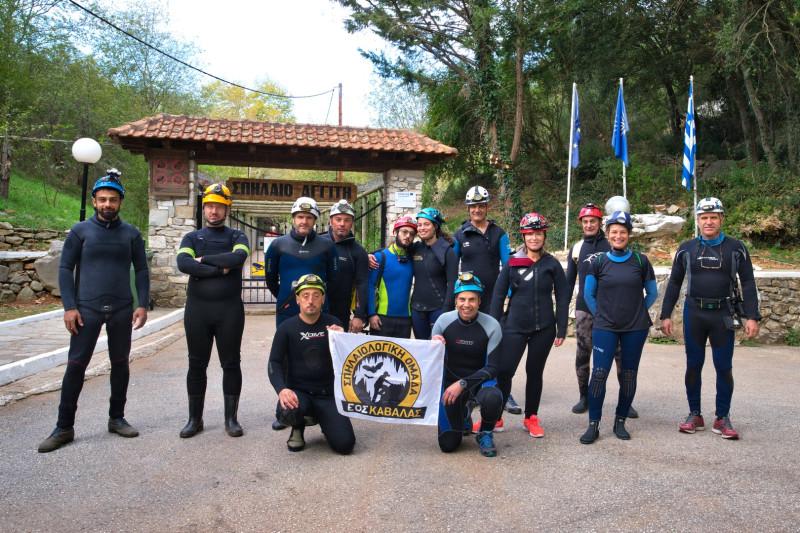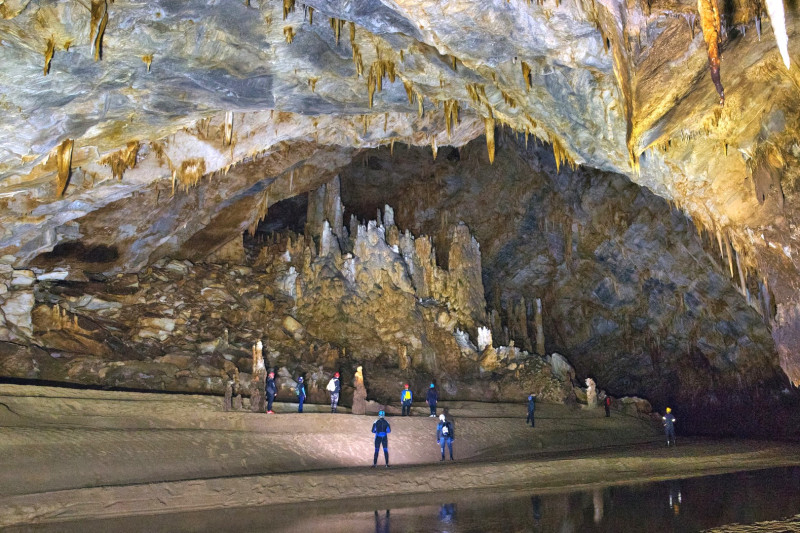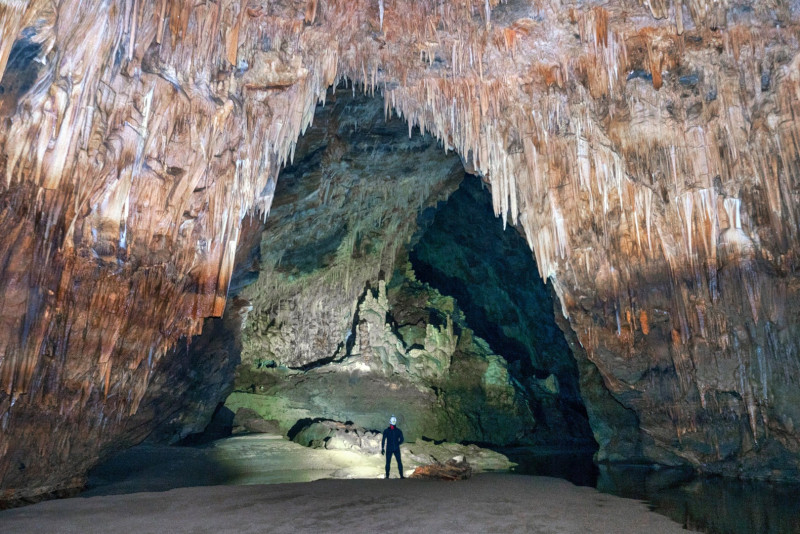The water level in the cave is “the lowest in recent years”, as speleologists characteristically emphasize in their statement
This year, the members of the speleological team of the Hellenic Mountaineering Association (EOS) Kavala 1933 found themselves in front of an unexpected picture during the annual exploration they carried out in the non-visitable part of the cave of the springs Agitis river.
They were surprised to find that the water level in the largest river cave in Greece is particularly low, “the lowest in recent years”, as they characteristically emphasize in their announcement.
A total of thirteen members, speleologists of the E.O.S Kavala 1933, after permission, which was kindly granted to them by the Paleoanthropology – Speleology Tax Office of Northern Greece, found themselves in the non-visitable part of the cave “Pigon Aggiti” (Maaras), which is fed hydrologically, both by the Menoiki mountain as well as the sinkholes of its basin Kato Neurokopiou.
“Among the remarkable things of the visit – exploration, beyond the large and impressive rooms in dimensions and cave themes, is the lowest water level that we have observed in all these years of our visits. This reduction is due to the increased temperatures and reduced rainfall and snowfall, obviously a sign of the suffering that reckless human interventions are causing to the karst aquifers and the global climate,” the relevant announcement points out.
The speleologists of E.O.S. Kavalas 1933 carry out regular explorations in the non-visitable part of the Aggitis cave, which is not accessible to the thousands of visitors who flock throughout the year to admire this unique monument of nature up close. However, the non-visitable section is considered even more impressive for those who have the privilege of seeing it up close.
The cave is located 23 kilometers northwest of the city of Drama, in the community of Kokkinogeion of the municipality of Prosotsani and is the only exploitable river cave in Greece. The natural environment impresses the visitor, while the waterfalls that formed inside the gorge when there was sufficient water created an atmosphere of unique natural beauty. Unfortunately, the current picture of the riverside cave is disheartening for those who had visited it in the past and today they face an almost dry natural landscape.
K. Papadopoulos: “We need snow to enrich the water table”
“In the last twenty-five years, it is the first time that the river level has fallen so low,” Kyriakos Papadopoulos, head of the Culture-Tourism department of the Prosotsani municipality, which manages the Aggitis cave, emphasizes, speaking to APE-MPE. “The picture is sad,” he continues, “and without the water the natural landscape of the cave and the surrounding area has changed. In fact, the surprise of those visitors who have come to the cave again and remember water being the dominant element is great, and today they find that the water is really minimal.”
The cave, of course, remains an impressive monument of nature. However, the lack of water is a decisive factor. It is enough to think that this was created by the erosion of the limestone rocks of Falakro Oros. In a journey of 12 km that begins thousands of years ago from the sinkholes of the closed basin of Nevrokopi, where the water from the winter snows and rains collects, the liquid treasure is transported to the Dramen plain.
Mr. Papadopoulos underlines that the rains alone are not enough to enrich the water table, there must be enough snowfall to irrigate the land and fill the underground natural reservoirs again.
18% increase in cave traffic
The cave of the river Agitis usually remained closed three to four months of the year, because the river level rose and access was difficult. “Weather conditions decisively affect access to the river cave,” notes Mr. Papadopoulos and adds: “it is usually open nine to ten months a year. There was a year when the cave was closed for seven whole months, as the rains were heavy, so the river level did not go down for a long time. In addition, the snowfalls affect the cave, since with the melting of the snow, large amounts of water are formed that penetrate it, finding a way out into the plain. The cave has the unique ability to regenerate itself. The fact that some months of the year it is closed and there is no human presence maintains its natural balance.” In 2024, the cave was not closed at all since the water level was low, so it could remain open year-round.
For the first time in 1978, Greek and French speleologists dived into the water and proceeded to the first 500m. Since then, approximately 12 km have been explored and 10 km of route has been mapped. Since 2000, when the operation of the cave began, the visitor can admire the first 500 meters. The Aggitis river cave is an impressive monument of nature. Thousands of years later it remains an active and active cave. The visitor becomes an eyewitness of the creation of a stalactite, experiencing the majesty of nature up close.
This is also the reason why in recent years more and more people visit it and admire it up close. Mr. Papadopoulos emphasizes “that this year, the traffic showed an increase of 18%. In fact, we also had foreign tourists, who found themselves in the area of Drama for the first time and visited it.”
*The photos were provided by the speleological team of E.O.S Kavala 1933
Source: Skai
I have worked as a journalist for over 10 years, and my work has been featured on many different news websites. I am also an author, and my work has been published in several books. I specialize in opinion writing, and I often write about current events and controversial topics. I am a very well-rounded writer, and I have a lot of experience in different areas of journalism. I am a very hard worker, and I am always willing to put in the extra effort to get the job done.













